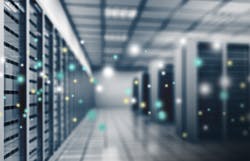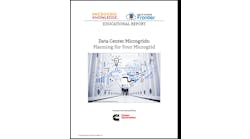Top Modernization Considerations To Support Digital Infrastructure
Last week we launched our article series on the new balance between the cloud and the modern data center. This week, we'll dive into some specific modernization considerations.
Modernization efforts are happening at all levels of digital infrastructure, and businesses are trying to be more efficient to impact time-to-market capabilities and improve uptime. With this in mind, let’s review the top considerations when examining infrastructure modernization.
1. Reducing Complexity: Not overcomplicating your technology or processes is crucial to finding the balance between cloud and on-prem.
An essential modernization effort to reduce admin fatigue is to gain control of data points and aggregate necessary management tools. Working with a good partner can help you visualize your infrastructure management structure and work on improvements. As data centers grow between cloud, edge and on- prem, we often lose sight of critical functions, including DCIM management, infrastructure maintenance and basic notetaking. Partners that include solutions focusing on hardware monitoring, ITSM integration, multivendor support and software maintenance for modern and legacy systems.
2. Working with modern workloads: You don’t have to look far to see a great example of this: ChatGPT and Generative AI. These technologies will vastly change how we design dense and efficient data center The rapid growth of these technologies has been nothing short of staggering.
Here is a metric to think about: A single Google search can power a 100w lightbulb for 11 seconds, consuming about .3 kWh of energy. A ChatGPT session consumes more than 50-100 times more power than a single Google search and can go as high as 3-4 kWh of energy. Generative AI and emerging machine learning neural network data models will consume more power. Further, these solutions will be a part of almost every data center model.
The carbon footprint of these large-language models (LLM) will also grow, as well as density requirements. Remember, these emerging use cases and workloads will change your digital infrastructure footprint.
3. Supporting IT departments more effectively: While data center operations are critical, we must also find ways to support IT teams more It’ll be essential for you to work with a partner that helps IT teams maximize infrastructure strategy and control costs. If your IT teams struggle to keep up with supporting the business, managed service providers (MSP) can help those teams focus on bringing value to the company, not on repetitive manual processes.
Despite supply chain obstacles and ever- present security threats, skilled IT leaders focus on reducing costs and diversifying data center workloads.
“Supply chain disruptions are forcing many IT teams to postpone their equipment refresh cycles — what was once a four-to-five-year cycle is now five-to-seven-years. We don’t see the delays letting up for at least another year but remember that today’s equipment is more capable and reliable than ever.” – CTO, Service Express.
That said, it’s critical to work with partners that help IT teams become more effective. As mentioned earlier, a good partner will help data centers adjust their equipment use. Due to ongoing supply chain disruptions, IT teams are running equipment longer. As a result, they’re seeing massive CapEx savings with an extended life cycle and utilizing all hardware more efficiently. Even hyperscale cloud providers are announcing extending equipment life one to two years longer than in the past.
4. Supporting legacy infrastructure as needed: Our industry discusses infrastructure modernization quite a bit, and it’s even the topic of this paper. However, not all infrastructure needs to be replaced. Legacy gear is sometimes required to help the business remain operational and functional.
Data center leaders turn to third-party maintenance (TPM) to support diverse requirements to accomplish more of their IT priorities. Support includes servers, storage, network and even software. Multivendor support for various critical systems also legacy infrastructure. A good TPM partner will help with legacy hardware monitoring and legacy software maintenance with dedicated teams.
5. Security and data control: Security is an ongoing concern for a company’s health and As the modern workforce moves away from traditional office settings, greater exposure requires protection from new vulnerabilities.
According to Uptime Institute’s 2022 Data Center Resiliency Survey, the vast majority (80%) of data center managers and operators experienced at least one outage in the last three years. And Forrester’s Costs of Planned and Unplanned Downtime Report found that 41% were hit with unexpected downtime every week or month. How much does this ultimately cost you? Uptime Institute’s 2022 Outage Analysis Report found that downtime costs continue to rise:
- More than 60% of outages cost more than $100,000, an increase from 39% in 2019.
- 15% of outages cost more than $1 million, an increase from 11% in 2019.
This is why it’s essential to have direct visibility into all assets and aspects of your data center operations. Gathering key pieces of infrastructure data into a centralized portal ensures you don’t miss critical updates. Without this visibility, you’ll lose insight over key pieces of your infrastructure. If that that starts to include key functions like updates and patches, you will experience outages and even a potential data breach. It becomes even more critical as your cloud, edge and data center systems become further distributed.
According to Uptime, the top priorities in the last five years have centered around security, processes and staff development. Security is making the as no company wants to risk making news for a security breach. Automating and streamlining processes improves efficiencies and outcomes. Keeping an engaged workforce requires investment in individual IT skill building to empower career development and offset staff burnout. Work with a good partner that addresses evolving strategies around infrastructure security and data control.
6. Managing critical data center services: Several considerations centered around properly managing core operations and services. These include warranty support, End of Life (EOL) services, maintenance coverage, engineering support, supply chain and replacement parts management, hardware monitoring, software maintenance and staff support. Amidst all this, we have modern and legacy systems requiring monitoring and control.
Cataloging your digital footprint to understand better support and maintenance functions is vital. If this sounds daunting, complexity and system fragmentation may be getting the best of your infrastructure. Cloud computing further complicates connected systems as we now have to focus on distributed resources.
A good partner will help you outline your essential data center services and work with you to address proper management. In finding your balance between cloud and on-premises, a good partner can help you find ways to gain control over distributed resources.
The cloud and data center balance
Previously, specific workloads, like development platforms, would get the automatic nod to move into the cloud. Today, considerations around data locality, security and latency mean we have to think twice about where we deploy certain workloads.
In the 2023 AFCOM State of the Data Center Report, respondents indicated they were moving diverse applications from the cloud to on-premise resources.
Deploying certain types of workloads, like custom applications, for example, into the cloud is no longer a default. Of course, it might still make sense to work with cloud services for many use cases, including development and containerization.
Cloud and the data center considerations
Understanding the cloud and data center balance is the thesis of this paper. We’ve reached a point in our industry where leaders better understand what needs to live in the cloud and what can live on-premises. In the latest Service Express 2023 Data Center and Infrastructure Report, organizations hold steady with on-prem data centers as the primary workhorse. The transition to colocation and cloud environments is slow and methodical, as on-prem data centers still house nearly half the respondents’ workload needs.
IT leaders continue to evaluate the best places for their data and workloads, shifting to and from public and private cloud providers and on-prem resources.
Further, as the report indicates, moving to the cloud is not simply a “lift and shift” exercise; it requires both architecture changes to applications and the specific skill set to manage those resources. While private and hyperscale cloud technologies are powerful, neither offers the perfect solution to all IT problems.
Companies have been repatriating workloads from the cloud as costs have ramped up beyond expectations. To be the most successful, IT leaders must adopt a hybrid strategy around multicloud and on-prem.
Download the full report, Top Methods To Modernize and Balance Your Infrastructure, featuring Service Express, to learn more. In our next article, we'll consider new key considerations in the data center and cloud balance.









